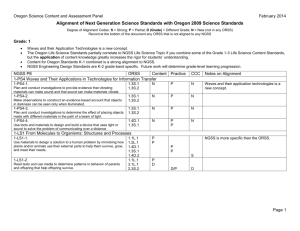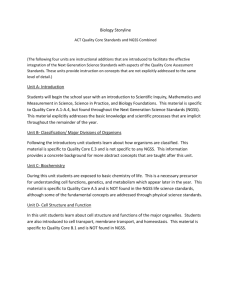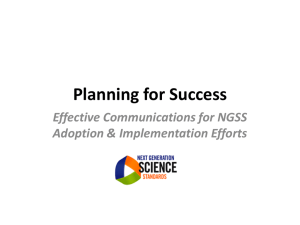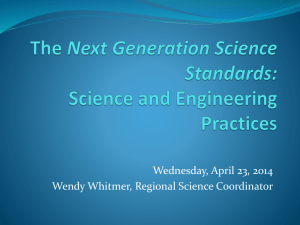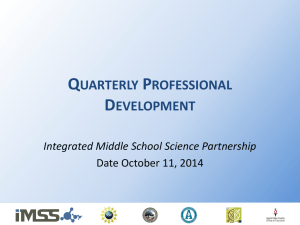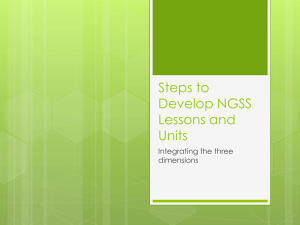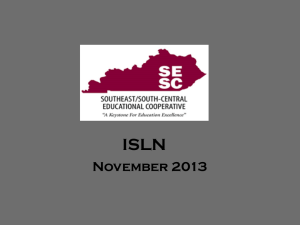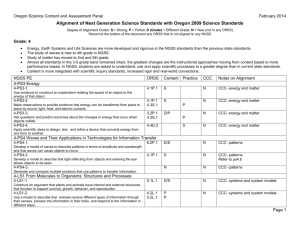Next Generation Science Standars Attachment NGSS ORSS
advertisement
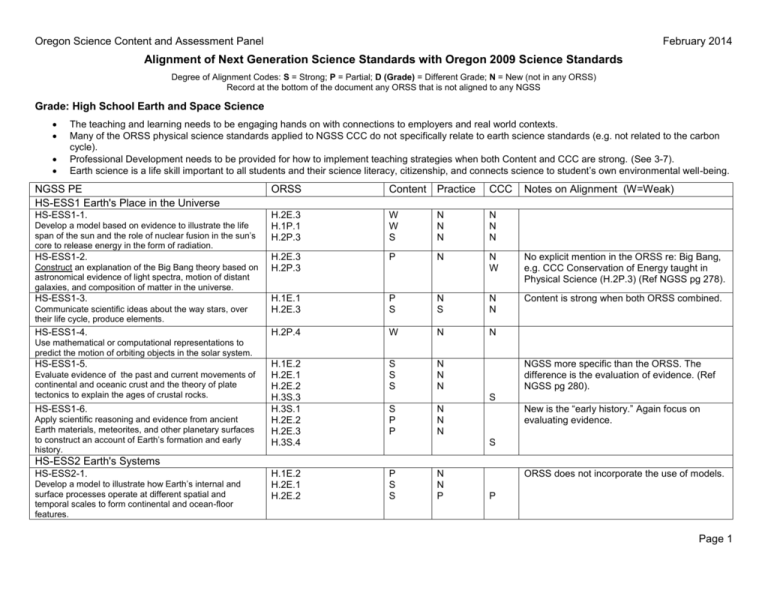
Oregon Science Content and Assessment Panel February 2014 Alignment of Next Generation Science Standards with Oregon 2009 Science Standards Degree of Alignment Codes: S = Strong; P = Partial; D (Grade) = Different Grade; N = New (not in any ORSS) Record at the bottom of the document any ORSS that is not aligned to any NGSS Grade: High School Earth and Space Science The teaching and learning needs to be engaging hands on with connections to employers and real world contexts. Many of the ORSS physical science standards applied to NGSS CCC do not specifically relate to earth science standards (e.g. not related to the carbon cycle). Professional Development needs to be provided for how to implement teaching strategies when both Content and CCC are strong. (See 3-7). Earth science is a life skill important to all students and their science literacy, citizenship, and connects science to student’s own environmental well-being. NGSS PE HS-ESS1 Earth's Place in the Universe ORSS Content Practice CCC HS-ESS1-1. H.2E.3 H.1P.1 H.2P.3 W W S N N N N N N H.2E.3 H.2P.3 P N N W No explicit mention in the ORSS re: Big Bang, e.g. CCC Conservation of Energy taught in Physical Science (H.2P.3) (Ref NGSS pg 278). H.1E.1 H.2E.3 P S N S N N Content is strong when both ORSS combined. H.2P.4 W N N H.1E.2 H.2E.1 H.2E.2 H.3S.3 H.3S.1 H.2E.2 H.2E.3 H.3S.4 S S S N N N S P P N N N H.1E.2 H.2E.1 H.2E.2 P S S Develop a model based on evidence to illustrate the life span of the sun and the role of nuclear fusion in the sun’s core to release energy in the form of radiation. HS-ESS1-2. Construct an explanation of the Big Bang theory based on astronomical evidence of light spectra, motion of distant galaxies, and composition of matter in the universe. HS-ESS1-3. Communicate scientific ideas about the way stars, over their life cycle, produce elements. HS-ESS1-4. Notes on Alignment (W=Weak) Use mathematical or computational representations to predict the motion of orbiting objects in the solar system. HS-ESS1-5. Evaluate evidence of the past and current movements of continental and oceanic crust and the theory of plate tectonics to explain the ages of crustal rocks. HS-ESS1-6. Apply scientific reasoning and evidence from ancient Earth materials, meteorites, and other planetary surfaces to construct an account of Earth’s formation and early history. NGSS more specific than the ORSS. The difference is the evaluation of evidence. (Ref NGSS pg 280). S New is the “early history.” Again focus on evaluating evidence. S HS-ESS2 Earth's Systems HS-ESS2-1. Develop a model to illustrate how Earth’s internal and surface processes operate at different spatial and temporal scales to form continental and ocean-floor features. N N P ORSS does not incorporate the use of models. P Page 1 Oregon Science Content and Assessment Panel February 2014 Alignment of Next Generation Science Standards with Oregon 2009 Science Standards Degree of Alignment Codes: S = Strong; P = Partial; D (Grade) = Different Grade; N = New (not in any ORSS) Record at the bottom of the document any ORSS that is not aligned to any NGSS Grade: High School Earth and Space Science NGSS PE ORSS Content Practice CCC Notes on Alignment (W=Weak) HS-ESS2-2. H.2E.1 H.2E.4 H.2L.2 H.3S.3 H.3S.5 H.2E.1 H.2E.2 H.2P.3 H.4D.5 H.2E.1 H.2E.2 H.2P.3 H.3S.3 All H.3 H.1E.2 H.1P.2 H.2E.1 H.2E.2 H.2E.4 H.2P.1 H.4D.6 H.1E.2 H.2E.1 H.2L.1 H.2E.2 H.2P.2 H.2P.3 S S S S N S N S P ORSS discusses systems but not feedback loops and stability (Ref NGSS pg 283). H.3S.5 addresses new technologies but not cost benefit analysis. S S S N N N S S S N N N S P P P P N S N N N N N N P S P P N N N N N Analyze geoscience data to make the claim that one change to Earth's surface can create feedbacks that cause changes to other Earth systems. HS-ESS2-3. Develop a model based on evidence of Earth’s interior to describe the cycling of matter by thermal convection. HS-ESS2-4. Use a model to describe how variations in the flow of energy into and out of Earth’s systems result in changes in climate. HS-ESS2-5. Plan and conduct an investigation of the properties of water and its effects on Earth materials and surface processes. HS-ESS2-6. Develop a quantitative model to describe the cycling of carbon among the hydrosphere, atmosphere, geosphere, and biosphere. P S Bloom’s taxonomy, NGSS has higher expectations. ORSS addresses new technology but not research and design. W Bloom’s taxonomy, NGSS has higher expectations. (Ref NGSS pg 285.) S P H.1P.2 lays the ground work for discussing this in the context of water. (Ref NGSS pg 282.) H.2E.1/H.2E.4 social/cultural contextualization. P S S Page 2 Oregon Science Content and Assessment Panel February 2014 Alignment of Next Generation Science Standards with Oregon 2009 Science Standards Degree of Alignment Codes: S = Strong; P = Partial; D (Grade) = Different Grade; N = New (not in any ORSS) Record at the bottom of the document any ORSS that is not aligned to any NGSS Grade: High School Earth and Space Science NGSS PE ORSS Content Practice CCC Notes on Alignment (W=Weak) HS-ESS2-7. H.2L.4 H.2L.5 H.2E.2 H.2E.3 H.2E.4 H.3S.1 H.3S.4 H.1L.4 H.2L.2 H.1L.3 H.2L.1 P P S P P P P P P P P N N N N N N N N N N N P P P P W This addresses both how the earth systems impacts biology and how biology impacts the earth systems. (Ref NGSS pg 283.) ORSS H.2E.4 doesn’t focus on NGSS CCC of stability and change. H.2E.4 H.3S.3 Other H.3 H.1P.1 H.2L.2 H.4D.5 H.4D.4 H.4D.6 H.2E.4 H.2P.3 S P N/W N/W P W N N N N P/W S P S P/W S P S N N N H.2L.2 H.2E.2 H.2E.4 H.4D.5 W W W N N N Construct an argument based on evidence about the simultaneous coevolution of Earth’s systems and life on Earth. P P W HS-ESS3 Earth and Human Activity HS-ESS3-1. Construct an explanation based on evidence for how the availability of natural resources, occurrence of natural hazards, and changes in climate have influenced human activity. HS-ESS3-2. Evaluate competing design solutions for developing, managing, and utilizing energy and mineral resources based on cost-benefit ratios. HS-ESS3-3. Create a computational simulation to illustrate the relationships among management of natural resources, the sustainability of human populations, and biodiversity. P S S P/W P N P H.1P.1 nuclear energy to mitigate greenhouse gasses creates hazards (Ref NGSS pg 287 & 288.) H.4D.6 doesn’t explicitly address macroeconomics (e.g., strength and weakness vs cost-benefit). Cool capstone project. Content and CCC are strong but implementation is another issue, this is a good place to involve students at all level of government. (Ref NGSS pg 287.) NGSS is addressing 2 things: 1 the computational simulation which ORSS doesn’t address, and 2 the content which is listed here. This is a STEM and math connection. Requires computer modeling skills and technological support/infrastructure. H.4D.5 is partial because NGSS highlights dependency on new technology vs ORSS use of technology. (Ref NGSS pg 288.) Page 3 Oregon Science Content and Assessment Panel February 2014 Alignment of Next Generation Science Standards with Oregon 2009 Science Standards Degree of Alignment Codes: S = Strong; P = Partial; D (Grade) = Different Grade; N = New (not in any ORSS) Record at the bottom of the document any ORSS that is not aligned to any NGSS Grade: High School Earth and Space Science NGSS PE ORSS Content Practice CCC HS-ESS3-4. H.4D.4 H.4D.5 H.4D.6 H.2E.4 H.3S.5 H.1E.2 H.2E.1 H.2E.2 H.2E.3 H.2E.4 H.3S.2 S W P S S W N N P N N N W W/P P P W P P N N N N N P H.2E.4 H.3S.2 H.4D.1 S N Evaluate or refine a technological solution that reduces impacts of human activities on natural systems. HS-ESS3-5. Analyze geoscience data and the results from global climate models to make an evidence-based forecast of the current rate of global or regional climate change and associated future impacts to Earth systems. HS-ESS3-6. Use a computational representation to illustrate the relationships among Earth systems and how those relationships are being modified due to human activity. P W P N W W Notes on Alignment (W=Weak) Great appropriate resources available (maybe have a website with these links). House bill 2544 in 2010 discusses eco-literacy. (Ref NGSS pg 285.) Modeling is absent from ORSS H.2E.x (all). (Ref NGSS pg 287.) NGSS is strong on modeling and its design components, e.g. inputs/outputs boundary conditions. Page 4
